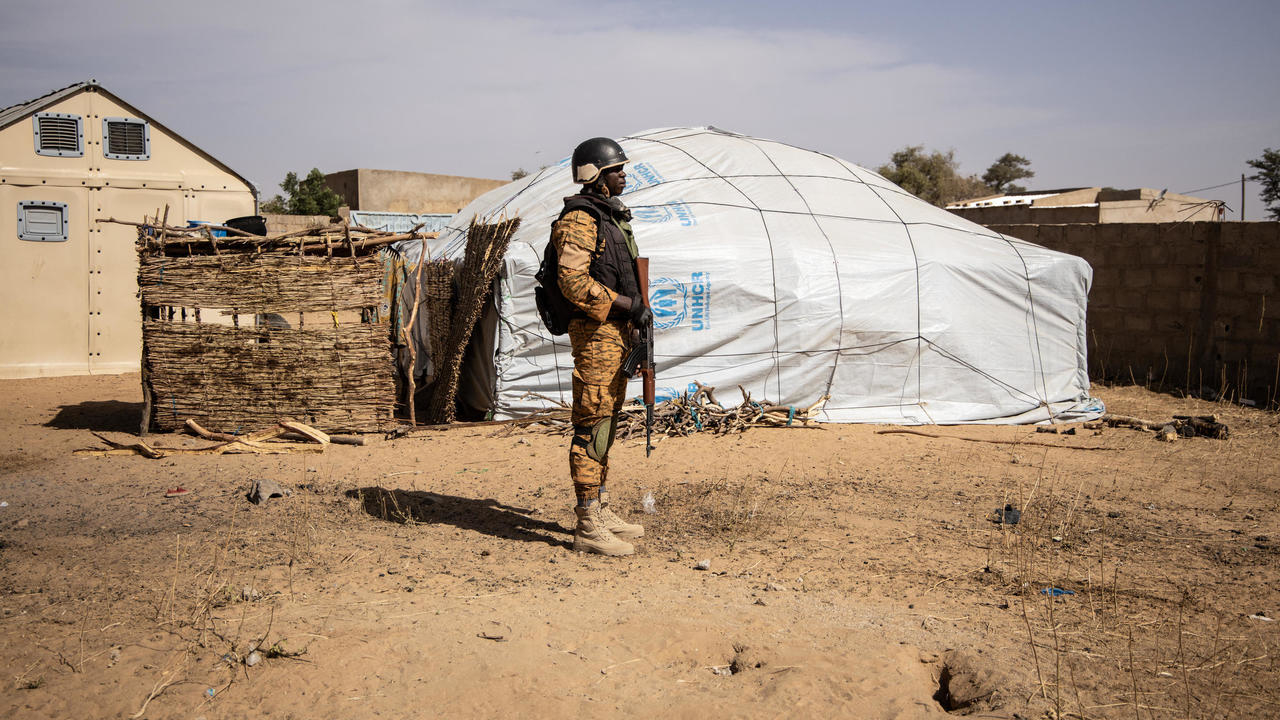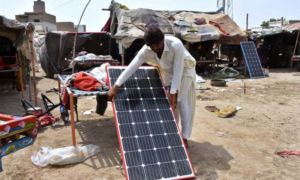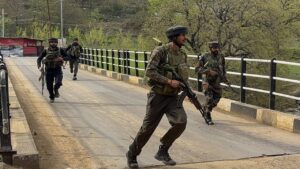
(FILES) In this file photograph taken on February 3, 2020, a Burkina Faso soldier patrols at a camp sheltering Internally Displaced People (IDP) from northern Burkina Faso in Dori.
At least 160 civilians, including volunteer anti-terrorism fighters, were killed in northern Burkina Faso on Friday in the deadliest Islamist attack in the country since 2015, plunging the country once more into mourning.
Advertising Read more
Burkina Faso is paying a high price for its role in the war on jihadism. Twin attacks in the West African country’s volatile northern region on Friday, launched within the space of a few hours, killed at least 160 people, including some 120 children.
The government has declared three days of national mourning following the deadliest Islamist attack since the insurgency began in 2015.
The largest massacre took place in Solhan, the capital of the region of the same name near the border with Mali and Niger in the so-called “three borders” zone. The town is known as a crossroads for thousands of prospective gold miners.
Assailants entered the town on about 20 motorbike at around 2am on Saturday morning. At first they targeted an outpost of the Volunteers for the Defence of the Fatherland (VDP), auxiliary forces of the Armed Forces in the fight against terrorism.
Then the terrorists moved towards houses where they massacred civilians indiscriminately.
The victims were mostly young, ranging in age from between 8 months to 45 years, according to security sources quoted by FRANCE 24’s sister station Radio France Internationale (RFI).
The attackers also looted, set fire to shops and burned vehicles before fleeing.
No one has yet claimed responsibility for the attack.
However, two main groups operating in the area have been identified as possible instigators: a local al Qaeda affiliate and the Islamic State group in the Greater Sahara (EIGS). Local groups such as Ansarul Islam, a movement founded at the end of 2016 by the radical imam Ibrahim Malam Dicko, the bulk of whose troops have joined EIGS, also operate in the area.
Relief efforts delayed
The armed forces reportedly arrived one to two hours after the jihadists left. “Military units are supposedly about 20 km away and yet the assailants were able to carry out their killing spree without being intercepted,” said journalist Vincent Hugeux in an interview with FRANCE 24.
Indeed, armed forces are stationed in Sebba, located about 10 km from Solhan, in the same province of Yagha. But the region has few safe points of passage.
“Access to Solhan is difficult, there is no road,” Mahamoudou Savadogo, a Burkinabe specialist in security issues, told FRANCE 24. “It’s essentially a track. You also have to be very careful with the mines that terrorists place on the route, which is also used by security forces.”
Three civilians were killed after the attack when the cart carrying them struck an improvised mine on the Solhan-Sebba road, according to a local politician interviewed by AFP.
“The Burkinabe army is insufficiently equipped,” said Tanguy Quidelleur, a politics and social sciences researcher at the French National Centre for Scientific Research (CNRS) in Paris.
“Moreover, intervening at night is extremely dangerous. Even during the day, they hesitate to patrol certain areas and prefer to barricade themselves in.”
The attack comes just a few weeks after a visit to the region by the Burkinabe Defence Minister, Chérif Sy, whose visit was meant to showcase the return of government authority after months of jihadist encroachment.
“It was badly timed,” said Hugeux. “The defence minister had visited the Sebba detachment on that occasion and had unwisely declared a return to normalcy.”
Savadogo, who conducts research into extremist groups, said he believed the attacks were a reaction to the government’s claims of victory, albeit small, in its fight against the insurgents and is part of a “war of communication” on both sides.
The bloodletting in Solhan appears to be a new step in the insurgents’ campaign to destabilise the Burkinabe state, which is already weakened and unable to provide security for its inhabitants in rural areas.
Civilians in danger
The first victims of the massacre were members of the VDP, a group made up of civilian volunteers who receive two weeks’ military training and are deployed to support the counter-insurgency.
“A number of disparate self-defence groups emerged after the security situation began to deteriorate in 2015,” explained Quidelleur. “These groups were institutionalised in 2020 with the creation of the VDP, and were tasked with supporting the regular army on both intelligence and operational missions.”
While the VDP has achieved significant success in some regions, many analysts say that they have also exposed the civilian population to reprisals. “Since February, the jihadists have waged open warfare against the VDP,” said Savadogo.
“We can think of it as a cycle of vendettas. At Solhan, the VDP post was attacked and then civilians massacred because they were considered complicit,” added Quidelleur. “Some VDPs themselves may have been guilty of acts against populations accused of collaborating or having family links with jihadists.”
Savadogo points to what he calls a “war of influence” between the al Qaeda affiliate and the Islamic State group in the tri-border area. Unlike other attacks, the assailants at Solhan targeted both men and women, youth and adults.
“Perhaps this massacre of civilians is a manoeuvre by the Islamic State to discredit al Qaeda, which operates in the area,” he said.
Whatever the reason, civilians are being increasingly targeted in Burkina Faso. The siege at Solhan was preceded a few hours earlier by another raid on the village of Tadaryat, in which at least 14 people, including a civilian soldier, were killed.
A week earlier, four people – including two members of the VDP – were killed in two other attacks in the same area.
“From 2019 and 2020, after targeting symbols of the state, the jihadists started to attack civilians because some of them are armed and viewed as fighters,” said Savadogo.
Since 2015, jihadist violence has killed more than 1,400 people and displaced more than one million in Burkina Faso.
This article has been translated from the original in French.
Daily newsletterReceive essential international news every morning Subscribe








